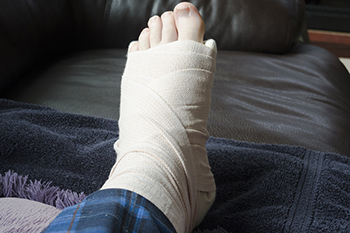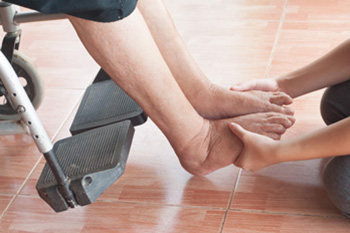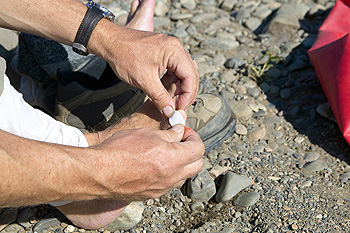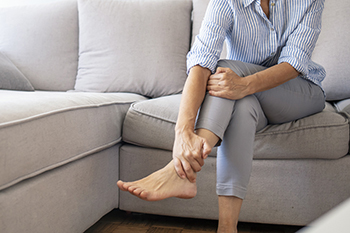Blog
Causes of Big Toe Joint Pain

One of the most important components of your foot is the big toe joint, scientifically known as the first metatarsophalangeal joint, or first MPJ. When issues arise within this joint, they can significantly impact your daily life, ranging from walking to overall body posture. Hallux limitus is a condition that pertains to the limited range of motion in the big toe joint. One of the main causes of this condition is inflammatory arthritis. Your big toe joint plays a critical role in walking and maintaining proper balance. When this joint loses its range of motion it can lead to significant difficulties in walking and cause pain during each step. This can alter the gait and in turn affect the knee, hip, and back. If arthritis is a contributing factor, disease specific medications can be prescribed. In severe cases, surgical intervention may be needed. Procedures can range from cleaning out the joint to more advanced surgeries, such as joint fusion or joint replacement. For an accurate appraisal of the problems involving your big toe pain, it is suggested that you make an appointment with a podiatrist.
Toe pain can disrupt your daily activities. If you have any concerns, contact one of our podiatrists of James Kutchback, DPM, CWS-P. Our doctors can provide the care you need to keep you pain-free and on your feet.
What Causes Toe Pain?
Most severe toe pain is caused due to a sports injury, trauma from dropping something heavy on the toe, or bumping into something rigid. Other problems can develop over time for various reasons.
Toe pain can be caused by one or more ailments. The most common include:
- Trauma
- Sports injury
- Wearing shoes that are too tight
- Arthritis
- Gout
- Corns and calluses
- Hammertoe
- Bunions
- Blisters
- Ingrown toenails
- Sprains
- Fractures (broken bones)
- Dislocations
When to See a Podiatrist
- Severe pain
- Persistent pain that lasts more than a week
- Signs of infection
- Continued swelling
- Pain that prevents walking
Diagnosis
In many cases the cause of toe pain is obvious, but in others, a podiatrist may want to use more advanced methods to determine the problem. These can range from simple visual inspections and sensation tests to X-rays and MRI scans. Prior medical history, family medical history, and any recent physical traumatic events will all be taken into consideration for a proper diagnosis.
Treatment
Treatments for toe pain and injuries vary and may include shoe inserts, padding, taping, medicines, injections, and in some cases, surgery. If you believe that you have broken a toe, please see a podiatrist as soon as possible.
If you have any questions please contact our offices located in The Woodlands and Woodville, TX . We offer the newest diagnostic and treatment technologies for all your foot and ankle needs.
Fundamental Insights on Preventing Running Injuries

Embarking on a running journey brings not just the thrill of the track but also the responsibility of safeguarding against potential injuries. Start with a proper warm-up, gradually transitioning from brisk walking to a light jog, allowing muscles to adapt to the forthcoming activity. Choosing the right footwear is paramount. Opt for shoes that provide adequate support and cushioning based on your foot arch and running terrain. Maintain a balanced training routine that incorporates strength and flexibility exercises, focusing on core muscles and leg stability. Listen to your body and incorporate rest days to allow for recovery and muscle repair. Pay attention to running surfaces, choosing softer terrains when possible to reduce the impact on joints. Lastly, progress your running intensity gradually to avoid overexertion. If you would like more information about how to prevent running injuries in addition to protecting the feet, it is suggested that you consult a podiatrist.
All runners should take extra precaution when trying to avoid injury. If you have any concerns about your feet, contact one of our podiatrists of James Kutchback, DPM, CWS-P. Our doctors will treat your foot and ankle needs.
How to Prevent Running Injuries
There are a lot of mistakes a runner can make prior to a workout that can induce injury. A lot of athletes tend to overstretch before running, instead of saving those workouts for a post-run routine. Deep lunges and hand-to-toe hamstring pulls should be performed after a workout instead of during a warmup. Another common mistake is jumping into an intense routine before your body is physically prepared for it. You should try to ease your way into long-distance running instead of forcing yourself to rush into it.
More Tips for Preventing Injury
- Incorporate Strength Training into Workouts - This will help improve the body’s overall athleticism
- Improve and Maintain Your Flexibility – Stretching everyday will help improve overall performance
- “Warm Up” Before Running and “Cool Down” Afterward – A warm up of 5-10 minutes helps get rid of lactic acid in the muscles and prevents delayed muscle soreness
- Cross-Training is Crucial
- Wear Proper Running Shoes
- Have a Formal Gait Analysis – Poor biomechanics can easily cause injury
If you have any questions, please feel free to contact our offices located in The Woodlands and Woodville, TX . We offer the newest diagnostic and treatment technologies for all your foot care needs.
Methods That May Help to Prevent Diabetic Limb Loss

Approximately 60,000 lower extremity amputations are performed annually in the United States in patients with diabetes. This fact makes ulceration, infection, and gangrene a prevalent foot and ankle issue for diabetics people. Many amputations can be prevented through daily foot care habits and regular visits to a podiatrist to monitor foot ulcers. These experts suggest adopting an everyday foot care routine of inspecting the feet thoroughly for any changes in shape, color, sensation, or skin integrity. To prevent complications, podiatrists also recommend a gentle cleaning that involves washing feet in lukewarm water with mild soap, avoiding soaking, and ensuring thorough drying, especially between the toes. Nail care includes trimming nails straight across, avoiding rounding the corners. Callus management suggests gently reducing calluses with a foot file or pumice stone, rubbing in one direction to avoid skin tears. Diabetic patients should opt for cushioned, breathable shoes with soft uppers. Choosing cotton or natural fiber socks over synthetic materials is recommended. If you have diabetes, and are experiencing foot ulcers, it is suggested that you are under the care of a podiatrist who is medically trained to manage this condition.
Limb salvage can be an effective way in preventing the need for limb amputation. If you have diabetes, cancer, or any other condition that could lead to foot amputation if left unchecked, consult with one of our podiatrists from James Kutchback, DPM, CWS-P. Our doctors will assess your condition and provide you with quality foot and ankle treatment.
What Is Limb Salvage?
Limb salvage is the attempt of saving a limb, such as the foot from amputation. Podiatrists also try to make sure that there is enough function in the foot after the salvage that it is still usable. Diabetes is the number one cause of non-traumatic amputations in the United States. Those with diabetes experience poor blood circulation, which prevents proper healing of an ulcer. If the ulcer is left uncheck, it could become infected, which could result in the need for amputation.
However, there are other causes as well, such as cancer and traumatic injury. Links between higher mortality rates and amputation have been found. This translates into higher healthcare costs, and a reduced quality of life and mobility for amputees. Podiatrists have attempted to increase the prevalence of limb salvage in an attempt to solve these issues.
Diagnosis and Treatment
Limb salvage teams have grown in recent years that utilize a number of different treatments to save the infected limb. This includes podiatrists that specialize in wound care, rehabilitation, orthotics, and surgery. Through a combination of these methods, limb salvage has been found to be an effective treatment for infected limbs, and as an alternative to amputation. Podiatrists will first evaluate the potential for limb salvage and determine if the limb can be saved or must be amputated.
If you have any questions, please feel free to contact our offices located in The Woodlands and Woodville, TX . We offer the newest diagnostic and treatment technologies for all your foot care needs.
Diagnosis of Foot Fractures

Foot fractures are a relatively frequent occurrence, particularly involving the metatarsals and toes. Patients typically show up with a range of signs and symptoms, most commonly pain and difficulty walking. To make a diagnosis, X-rays are typically necessary, although emerging evidence suggests that ultrasonography may be just as reliable. The course of action depends on the fracture's location and its impact on balance and weight-bearing ability. In the case of metatarsal shaft fractures, the initial treatment involves a posterior splint and avoiding activities that involve putting weight on the foot. Subsequent treatment entails using a short leg walking cast or boot for a period of four to six weeks. Other fractures are treated differently. If you feel you have broken your foot, it is strongly suggested that you make an appointment with a podiatrist as quickly as possible for a proper diagnosis and treatment that is appropriate for you.
A broken foot requires immediate medical attention and treatment. If you need your feet checked, contact one of our podiatrists from James Kutchback, DPM, CWS-P. Our doctors can provide the care you need to keep you pain-free and on your feet.
Broken Foot Causes, Symptoms, and Treatment
A broken foot is caused by one of the bones in the foot typically breaking when bended, crushed, or stretched beyond its natural capabilities. Usually the location of the fracture indicates how the break occurred, whether it was through an object, fall, or any other type of injury.
Common Symptoms of Broken Feet:
- Bruising
- Pain
- Redness
- Swelling
- Blue in color
- Numbness
- Cold
- Misshapen
- Cuts
- Deformities
Those that suspect they have a broken foot shoot seek urgent medical attention where a medical professional could diagnose the severity.
Treatment for broken bones varies depending on the cause, severity and location. Some will require the use of splints, casts or crutches while others could even involve surgery to repair the broken bones. Personal care includes the use of ice and keeping the foot stabilized and elevated.
If you have any questions, please feel free to contact our offices located in The Woodlands and Woodville, TX . We offer the newest diagnostic and treatment technologies for all your foot care needs.
The Importance of Addressing Foot Pain

Foot pain, often dismissed as a minor inconvenience, can be a red flag signaling underlying issues that demand attention. Our feet, the unsung heroes of daily mobility, bear the brunt of your activities, and persistent pain is their cry for help. Ignoring foot pain may lead to a cascade of consequences, affecting not only your mobility but also your overall well-being. Whether stemming from overuse, wearing improper footwear, or underlying medical conditions, foot pain can be a precursor to more severe issues like stress fractures, tendonitis, or nerve disorders. Chronic discomfort may impact posture, causing a ripple effect on the entire musculoskeletal system. It is essential to recognize that your feet are intricate structures requiring care and attention. Addressing foot pain promptly through proper diagnosis and treatment not only ensures a smoother journey on your feet but also safeguards against potential complications that may arise when warnings are dismissed. If you have developed any type of foot pain, it is strongly suggested that you schedule an appointment with a podiatrist who can determine what the reason is and offer effective relief and treatment options.
Foot Pain
Foot pain can be extremely painful and debilitating. If you have a foot pain, consult with one of our podiatrists from James Kutchback, DPM, CWS-P. Our doctors will assess your condition and provide you with quality foot and ankle treatment.
Causes
Foot pain is a very broad condition that could be caused by one or more ailments. The most common include:
- Bunions
- Hammertoes
- Plantar Fasciitis
- Bone Spurs
- Corns
- Tarsal Tunnel Syndrome
- Ingrown Toenails
- Arthritis (such as Gout, Rheumatoid, and Osteoarthritis)
- Flat Feet
- Injury (from stress fractures, broken toe, foot, ankle, Achilles tendon ruptures, and sprains)
- And more
Diagnosis
To figure out the cause of foot pain, podiatrists utilize several different methods. This can range from simple visual inspections and sensation tests to X-rays and MRI scans. Prior medical history, family medical history, and any recent physical traumatic events will all be taken into consideration for a proper diagnosis.
Treatment
Treatment depends upon the cause of the foot pain. Whether it is resting, staying off the foot, or having surgery; podiatrists have a number of treatment options available for foot pain.
If you have any questions, please feel free to contact our offices located in The Woodlands and Woodville, TX . We offer the newest diagnostic and treatment technologies for all your foot care needs.
Elderly Foot and Ankle Problems

Foot and ankle problems are prevalent medical issues, particularly among the elderly, who often suffer from pain, stiffness, swelling, or deformities. Common diagnoses include conditions such as corns, athlete's foot, bunions, flat feet, ingrown nails, and warts. Aging-related muscle mass and loss of bone strength may increase seniors' risk for injuries and fractures, compounded by balance and vision issues. Key foot and ankle injuries in the elderly include ankle sprains, where the ligaments are overstretched or torn, potentially weakening the ankle and leading to arthritis, if untreated. Achilles tendonitis and tears are also common. The Achilles is vulnerable to inflammation and overuse, which can escalate to tears or ruptures, especially with sudden trauma. Ankle fractures are serious injuries from traumatic impact, requiring immediate podiatric attention to prevent complications such as infections. The spectrum of foot and ankle injuries in the elderly ranges from minor, treatable conditions to severe injuries necessitating medical intervention, highlighting the need for attentive care to prevent these issues. If you are elderly and have foot or ankle problems, it is suggested that you make an appointment with a podiatrist for a proper diagnosis and treatment.
Ankle pain can be caused by a number of problems and may be potentially serious. If you have ankle pain, consult with one of our podiatrists from James Kutchback, DPM, CWS-P. Our doctors will assess your condition and provide you with quality foot and ankle treatment.
Ankle pain is any condition that causes pain in the ankle. Due to the fact that the ankle consists of tendons, muscles, bones, and ligaments, ankle pain can come from a number of different conditions.
Causes
The most common causes of ankle pain include:
- Types of arthritis (rheumatoid, osteoarthritis, and gout)
- Ankle sprains
- Broken ankles
- Achilles tendonitis
- Achilles tendon rupture
- Stress fractures
- Bursitis
- Tarsal tunnel syndrome
- Plantar fasciitis
Symptoms
Symptoms of ankle injury vary based upon the condition. Pain may include general pain and discomfort, swelling, aching, redness, bruising, burning or stabbing sensations, and/or loss of sensation.
Diagnosis
Due to the wide variety of potential causes of ankle pain, podiatrists will utilize a number of different methods to properly diagnose ankle pain. This can include asking for personal and family medical histories and of any recent injuries. Further diagnosis may include sensation tests, a physical examination, and potentially x-rays or other imaging tests.
Treatment
Just as the range of causes varies widely, so do treatments. Some more common treatments are rest, ice packs, keeping pressure off the foot, orthotics and braces, medication for inflammation and pain, and surgery.
If you have any questions please feel free to contact our offices located in The Woodlands and Woodville, TX . We offer the newest diagnostic tools and technology to treat your foot and ankle needs.
Common Causes of Blisters on the Feet

Your feet support your entire body weight and endure constant friction from the size and fit of your footwear. Over time, this stress can lead to the formation of fluid-filled sacs beneath the skin, resulting in painful foot blisters. Foot blisters are often caused by shoes that are either too loose or too tight. They can rub against your skin, causing friction that leads to blister formation. The irritation from an ill-fitting shoe can create a blister in no time, particularly if you're on your feet for an extended period. Engaging in strenuous activities like athletics, running, or hiking can subject your feet to excessive stress and friction. These repetitive movements and the impact of your feet against hard surfaces can create the perfect conditions for blisters to form. In addition, diabetics, especially those experiencing neuropathy, are more at risk of developing recurring sores that resemble burn blisters on the top of the feet. Preventing foot blisters often comes down to choosing appropriate footwear, maintaining good foot hygiene, and avoiding excessive friction. If you have problems with blisters on the feet, it is suggested that you make an appointment with a podiatrist.
Blisters may appear as a single bubble or in a cluster. They can cause a lot of pain and may be filled with pus, blood, or watery serum. If your feet are hurting, contact one of our podiatrists of James Kutchback, DPM, CWS-P. Our doctors can provide the care you need to keep you pain-free and on your feet.
Foot Blisters
Foot blisters are often the result of friction. This happens due to the constant rubbing from shoes, which can lead to pain.
What Are Foot Blisters?
A foot blister is a small fluid-filled pocket that forms on the upper-most layer of the skin. Blisters are filled with clear fluid and can lead to blood drainage or pus if the area becomes infected.
Symptoms
(Blister symptoms may vary depending on what is causing them)
- Bubble of skin filled with fluid
- Redness
- Moderate to severe pain
- Itching
Prevention & Treatment
In order to prevent blisters, you should be sure to wear comfortable shoes with socks that cushion your feet and absorb sweat. Breaking a blister open may increase your chances of developing an infection. However, if your blister breaks, you should wash the area with soap and water immediately and then apply a bandage to the affected area. If your blisters cause severe pain it is important that you call your podiatrist right away.
If you have any questions, please feel free to contact our offices located in The Woodlands and Woodville, TX . We offer the newest diagnostic and treatment technologies for all your foot care needs.
Types of Arthritis That Can Impact the Feet

Various forms of arthritis can have specific effects on the feet. Osteoarthritis, or OA, most often affects the first metatarsophalangeal joint, connecting the big toe to the foot. It can also be found in the midfoot and ankle. In contrast, rheumatoid arthritis, or RA, typically appears in both feet and affects the same joints symmetrically. Gout is known for frequently targeting the feet, particularly the big toe, and causing intense pain during flares ups. Psoriatic arthritis, or PsA, can impact the toes, leading to swollen, sausage-like digits known as dactylitis. Additionally, it often involves inflammation at the points where tendons and ligaments attach to bones. The feet can be affected, resulting in plantar fasciitis and painful bone spurs, among other conditions. Ankylosing spondylitis also brings about plantar fasciitis and discomfort at the Achilles tendon, affecting the feet. Each of these types of arthritis presents distinct challenges and symptoms in the foot region. If you have foot pain, it is suggested that you make an appointment with a podiatrist to discuss whether arthritis may be the cause. This type of doctor can determine what type of arthritis has developed and guide you toward the necessary treatments for relief.
Arthritis can be a difficult condition to live with. If you are seeking treatment, contact one of our podiatrists from James Kutchback, DPM, CWS-P. Our doctors can provide the care you need to keep you pain-free and on your feet.
Arthritic Foot Care
Arthritis is a joint disorder that involves the inflammation of different joints in your body, such as those in your feet. Arthritis is often caused by a degenerative joint disease and causes mild to severe pain in all affected areas. In addition to this, swelling and stiffness in the affected joints can also be a common symptom of arthritis.
In many cases, wearing ill-fitting shoes can worsen the effects and pain of arthritis. Wearing shoes that have a lower heel and extra room can help your feet feel more comfortable. In cases of rheumatoid arthritis, the arch in your foot may become problematic. Buying shoes with proper arch support that contour to your feet can help immensely.
Alleviating Arthritic Pain
- Exercises that stretch the foot can prevent further pain and injury and increase mobility
- Most of the pain can be alleviated with anti-inflammatory drugs, heat, and topical medications
- Massages can help temporarily alleviate pain.
It is best to see your doctor for the treatment that is right for your needs and symptoms. Conditions vary, and a podiatrist can help you determine the right method of care for your feet.
If you have any questions please feel free to contact our offices located in The Woodlands and Woodville, TX . We offer the newest diagnostic tools and technology to treat your foot and ankle needs.





